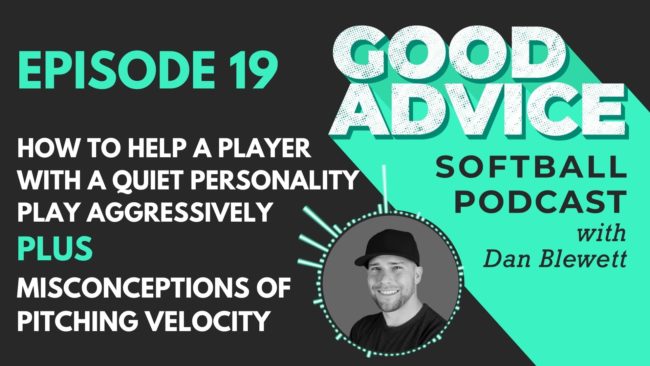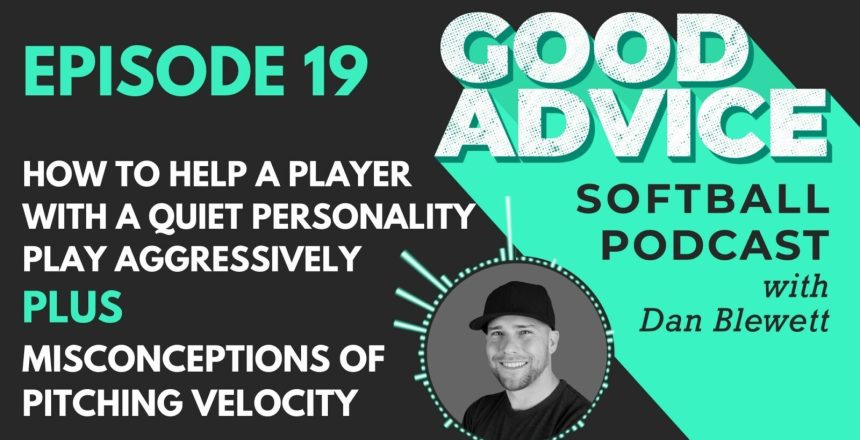*This article may contain product links which pay me a small commission if you make a purchase. Learn more.
In this episode, Dan discusses how to help a girl with a quiet personality play aggressively. Dan also talks through some of the misconceptions of pitching velocity as well as what’s realistic for pitchers when it comes to pitching velocity.
Try the Early Work Strength Program for free here.
To submit a question for the Good Questions Q&A segment, make a voice recording and email it to Dan at hello@danblewett.com. Want to support the show? Enroll in one of Coach Dan’s online throwing courses or his mental skills course. Use code GOODADVICE to save 20% on any course, just for being a listener. Sign up for Dan’s Email list and get his free throwing eBook, and follow up with him on the interwebs: YouTube Channel | Twitter | Snapsoftball.com
Podcast: Play in new window | Download
Subscribe: Apple Podcasts | Spotify
Transcript: EP19 – How to Help a Player with a Quiet Personality Play Aggressively & The Misconceptions of Pitching Velocity
You are listening to the Good Advice, Softball Podcast. I’m Dan Blewett. And on this show, you’ll learn how to help the softball player in your life. Sharpen her skills, improve her mindset and find new confidence through softball.
All right. Welcome back to the Good Advice softball podcast. I’m Dan Blewett in today’s episode, we’ve got two topics. I’m going to cover. Number one, how do you help a girl with a quiet sort of not overly aggressive personality? How do you help her get more out of her body? So she’s swinging aggressively pitching aggressively, you know, getting as much velocity and, power out of her frame as possible.
That can definitely be a challenge. And personality type definitely matters. And then number two, sort of along the same lines, we’re going to talk about pitching velocity and some of the misconceptions about it. I think it’s, often misunderstood what parents can expect, what coaches can expect from players.
And, you know, what’s realistic as far as like average velocity, peak velocity, all that sort of stuff.
Okay. So first thing, you know, players all have their different personality types. You know, if you follow things like the Myers Briggs or the Enneagram. You’ll know that humans are sort of, we do fall into sort of different buckets and categories and our personalities, and definitely fall within a range. Right.
There’s introverts there’s extroverts, but in reality, we’re all sort of on the continuum, right? So no, one’s like purely an introvert or, you know, you might be 32% introvert and. 76%, extrovert and, you know, couple of percentage points, something else. So there’s never, you know, you can’t necessarily emulate one other, a different players, personality types.
You have to take that into account. Some players is more contemplated, less aggressive. Some players are, hyper aggressive and not real deep thinkers, or, you know, there’s any combination of attributes that players can have. And so I think sometimes parents sometimes think that, Hey. You know, if only my daughter could just be more aggressive and just like really put some more oomph into it, and that might be true.
And that might be a worthwhile goal, trying to get that out of them. It just might not be the way that they operate. And so you have to sort of figure that out. Like if you look at the highest levels of baseball and softball, there are some players that are just more of like finesse kind of players that aren’t super hyped up, super pumped up that aren’t.
Flame throwers and they still get by and they do their thing. And I don’t know, there’s lots of examples where players are converted from one into the other. Now that being said, there is a certain amount of aggressiveness you have to have as a baseline to get to your highest pitching velocity.
If you’re a pitcher, Or as a hitter you can’t go up there and just swing at 80% and you can’t go out there and pitch at 90% because you just won’t have enough velocity on tap to do that. You know, if you threw a hundred miles per hour in baseball, you could throw 95% and still throw pretty hard. You know, if you threw 75 underhand in softball, you could go out there and throw 90% and still throw pretty hard.
But most players will never have the premium velocity to do that. So for players that are not overly aggressive, who maybe have that quiet personality, I think it’s just starting to challenge them and figure out how they respond to challenges, get them in front of other players. you know, maybe take them to college camps where they can see some of the older players and wow, how hard they throw, how hard they hit, get them to talk to other older players or former players.
You know, send them interviews of former players and have them talk about their mindset and stuff like that. And it’s really just exposing them to lots of different voices and having them see in action, what other players do, because they don’t really, they only really know their baseline. And that’s the other thing, if you can’t always tell the players effort level by how they look and you say, well, you’re not even like trying that hard, then they might say, no, I am.
I sort of feel like I am. And that’s valid. So I’ve definitely been there. Where if you ever watched me pitch in baseball, I didn’t look like I was throwing the max effort, but I was pretty close to max effort. It just like my max effort looked different than someone else’s. And so for someone who could come to me and be like, man, you could throw way harder.
If you just try it, I’d be like, dude, I’m trying, like my trying just looks different than you’re trying. So. It’s hard to know as a parent, how they perceive their effort level too. And also just, you know, when they feel like they mentally get out of control, all that sort of stuff, it’s not just pitching again.
It’s hitting also some players just naturally more aggressive the way they swing the bat. So there is no one magic bullet or magic thing to say to get a player to snap out of any of it. for overhand throwing, I think long toss is a good tool, especially with smaller, lighter balls than a full-size softball, because you know, long tossing, you’re challenging yourself to throw a little bit farther.
So you can all, you automatically have to reach back for a little extra and like hold onto it and really get that last little bit of it to throw that ball a little bit farther, especially you have a, you know, maybe you’re trying to Chuck it over a fence or you’re just. You know long tossing with a partner and they’re getting pretty far and you missed them last time you know, landed at their feet and this next one, you want to hit them in the chest, giving them that physical challenge is helpful.
Radar gun can be helpful as a tool, but I don’t think subjecting your players to having to be on a radar gun all the time is necessary either. That’s exhausting mentally. And you just physically can’t reach your top velocity every day. You know, that’s the difference between, you know, 60 miles per hour and 58 is pretty negligible.
That’s only like one and a half percent or 2%. So you know, that two or 3% or whatever is very negligible output difference. And so to say, Oh, you only hit 58 today. It’s like, well, 58 today is 60 tomorrow. Depends on how fresh I am or how much sleep I got or how much food I ate or. Maybe I was tired from a workout.
So your baseline always changes. And that’s what they call autoregulation in the strength training world that you can’t expect. You know, you can’t say, well, your max was 500 pounds on squats. So therefore today you have to do 95% of your maps. That means you have to do 490 pounds. you know, that’s, I don’t think I did that math.
Right. But that I don’t really care at the moment. but you know, that might not be their max that day 500 pounds. It might’ve been their max a week ago and they like true all time record, but just cause they did the 500 pounds last Thursday doesn’t mean they’re capable of doing 500 pounds. They walk in today.
Cause again, they could be tired, they could be dehydrated. They could have had a terrible night’s sleep. You know, all these different factors. And maybe today they’re at the absolute best their body could output is like 486 pounds. So they call that autoregulation where it’s basically just athletes listening to themselves as they build up.
So you’d start at 350 pounds and three 80, then 400, 420 404, 460. And as you get closer towards that theoretical 500 pound max, then you start to say, well, is 500 actually in the tank today. It doesn’t feel like it. So let’s say, all right, maybe my max is 480 today. So that’s how they kind of do that.
And you kind of have to have that same mindset with pitching where you’re just not going to get to your full speeds. And we’ll cover that a little more in the second topic, but again, for swinging the bat for sprinting, for throwing or pitching velocity, You know, these non-aggressive players who are quieter.
I don’t think you’re going to nag them into having more aggression. Number one, I think they’re just going to come to learn, to find a balance and maybe have a little more aggression in their game over time. But again, I think the number one way they’re going to get there. Is from being exposed to other players that can kind of show them the way, show them what a higher intensity looks like, or just show them that like, look, I throw away harder than you.
And that sort of puts a fire in the belly of a player to be a little more aggressive and say, no, I do have more, I can dig deeper and I can get a little more velocity. So it can be a challenge for parents. And I’ve heard that a bunch of different times, from both sports. So if you do have a player in your life, who’s not that aggressive.
Who’s kind of that quieter, maybe a little meek player. Like I said, it’s tough, but just do your best to encourage and put them in front of other people that might give them that little boost of enthusiasm to try it a little bit harder.
All right. In our second topic today, I want to talk about pitching velocity. So I mean I started to allude to this in the previous topic, which is that, you know, your peak is not always going to be there every day. And so with radar guns becoming more and more prevalent with pocket radar being a very good.
Cheap, relatively cheap, you know, easy to easily portable option. You know, players can be on the radar gun a lot more than they ever could. When I was a kid, I couldn’t afford a radar gun, like who could, they’re like 800 bucks back when, you know, with inflation 800 bucks was a lot more money than it is today.
And so, you know, the only people who had radar guns were some coaches and. Mostly Scouts. So like you didn’t even have access to it. But today there was a parent standing with pocket radar at every game, pretty much, right. And most high school programs have their own gun. All colleges do. And all pros obviously do as well.
And a lot of facilities have, you know, my facility had two radar guns on our walls, so. Velocity is more in it’s more omnipresent, it’s more in people’s minds and it’s more accessible. But I think what people don’t realize is that when your daughter who’s a pitcher reaches a new velocity milestone, or maybe it’s overhand throwing, and they reach a new velocity milestone, like they hit 60 for the first time you think, okay, well it’s now everything in the future is, you know, sixties, the new benchmark.
And that’s not really true. It’s a, it’s a new frame of reference. It’s the new high score, but just because you can touch. That doesn’t mean you can always reproduce that. So, you know, baseball, pitchers, no, this well, softball pitchers know this well, or at least the higher level ones that everyone’s going to have a max velocity.
And you think, Oh, why can’t you just reach back and get one extra miles per hour? Well, sometimes you just can’t, you’re just maxed out. And so. For a lot of players, especially the, you know, like underhand, like maybe 70 or 71 is your absolute max and your lifetime max, you’ve never hit hired in 71 as a pitcher, which is obviously exceptional.
But you know, when you hit 71, like what’s the difference between just getting a 72. Well, then why not? 73 then? Why not? 74. And then suddenly it’s like, well, yeah, at some point you really are maxed out. And so the true max speed is typically just going to be, it’s kind of like the bell curve where say your max is 71.
You’re not going to hit a 71 on every pitch. Like we already know that. Right. So then like how many 71’s will happen in a game or if your daughter’s 10 and our max is 52. How many 52’s can you really expect when that’s our absolute max speed? In a given game, she throws a hundred pitches. Maybe 10 of them are 52.
Right. And so it’s one of those things where. We sometimes think that the new high score immediately becomes this, the standard, the benchmark, and that we expected all the time, but it’s really when that new high score starts to become lower. Right. So when we have a even higher max score, That one becomes more prevalent.
So a 52 is your new, your new high. And then in two months now you hit 53 and then a month later you hit 54 because you’re growing now 52’s are there like 40% of your pitches. Right. And then a couple of years later, when you’re hitting 57, 52 is the low end of your range. And you only throw a couple 50 twos a game because you know, that’s like the slowest, like there’s no reason to ever throw all that slow anymore.
Right. Everything’s 56, 57. So. You really need to consider pitching velocity, not as this number that you’re looking for. So I think everyone just gets obsessed and they say, Oh, well, she hits 60. I want to see a bunch of sixties today. You might not see any, you know, if they just hit it one time their body might really just not be capable of doing it more than one time or two times or three times.
And, that’s pretty normal. And as they get stronger and their body gets comfortable throwing at, that speed, then it adapts. And then you’ll start to see a higher frequency of sixties and 60 ones. And then they’ll all start to come up. But really your velocity is always arranged. And even in the highest levels of softball and baseball, you see this so softball, if a player can touch 70, they’re probably 66 to 70 or 65 to 70, that’s their range.
They might touch 70, but they don’t pitch there. They pitch at 67 68. Same thing, even in major league baseball, you look at the graphs, the ranges of these players, you know, guys are 92 to 96, usually three or four mile power spread and given a whole season, it’s even bigger than that. When you’re taking into, you know, 2,000, 3,000, 4,000 pitches, that’s a pretty big range that they have.
So the big thing to remember is. You don’t want to start to just because you’re excited that you see a loss, you start to grow. You don’t want to start to set unrealistic expectations where now there’s a lot of pressure to continue to climb above that. Cause you just can’t climb in a slow linear fashion all the time.
Really it’s going to be, there might be some long plateaus, like they might gain five miles per hour in a 10 month period when they have a little growth spurt and then they might. Not gain a single miles per hour in the next six months. And then they might shoot up a couple more when they hit another growth spurt or jump in the weight room or whatever it is.
So velocity is not going to be a completely linear process. You don’t just gain 0.1 miles per hour every day. but over time, if you were to average, it might work out to like, to be something like that. Right. So it’s gonna just be little peaks and valleys. And the other thing is velocity is going to go down.
So just because you hit 60 yesterday, and last time you pitched your 58 to 60 does not mean you’ll be 58 to 60 next time. It takes a long time for young player’s velocity, to normalize where every time they’re out, they’re 60 to 62. Every single time they pitch they’re 64 to 66. It takes a while for them to do that, have they have to hone their routine.
They have to eat similarly throughout the week, they have to have consistent calories. Like their routine has to be very normal and young players have poor routines. They’re much more likely to have huge swings in how many calories they eat, because school is crazy. And they have so many activities and blah, blah, blah.
They’re often they don’t get enough sleep because of the crazy school hour. They have to get up, you know, getting up at 6:30. So there’s more fluctuations when you’re younger and it tends to normalize the older you get. So all those factors are important to understand just because pitching velocity, I think is a very misunderstood, even though it’s more measured than it’s ever been before.
Well, that’s all the good advice I’ve got for today. If you enjoy the show and would like to support me while also helping yourself enroll today in one of my online softball courses, my She’s Got a Cannon throwing courses, come with pricing plans for any budget. And my Resolute Athlete, mental skills course will help your daughter or team build the mindset of a champion.
Enroll in any of my courses through the links in the show notes and save 20% with code good advice just for being a listener. Be sure to subscribe to my weekly email list where you’ll get updates on all my new videos and episodes, nearly 4,000 people get my emails and you should to sign up for the link in the show notes.
Lastly, who do you know, who can use some good advice? Please share this podcast with a friend, subscribe on iTunes, Spotify, or wherever you listen to podcasts and subscribe to my snap softball, YouTube channel, where you’ll find this podcast and hundreds of softball, instructional videos. Back when I was a player, I was always thankful for good coaches and good advice.
I’m Dan Blewett and I’ll see you next time.







